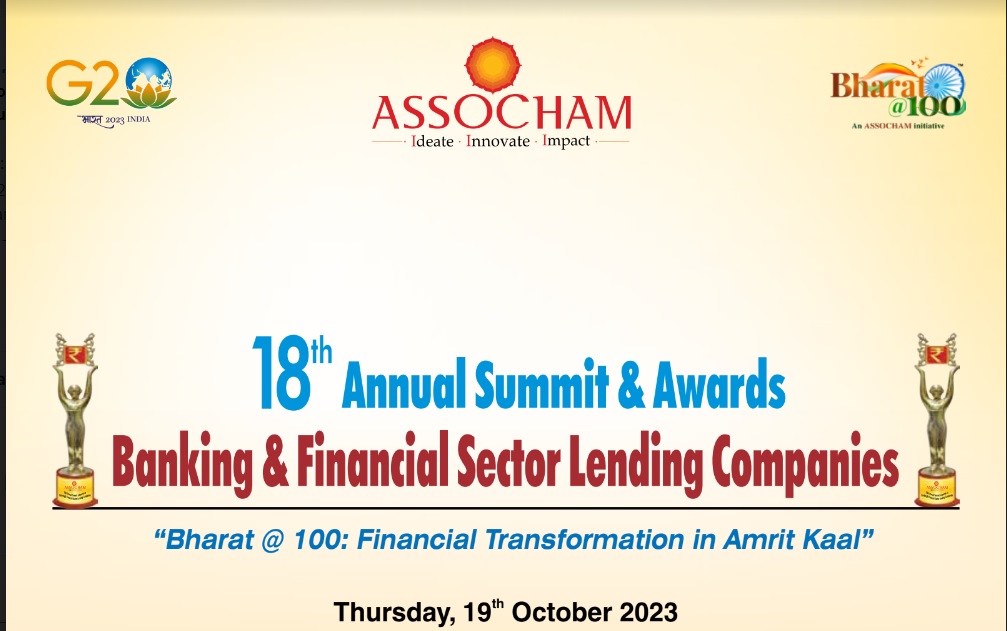18th ASSOCHAM Annual Summit & Awards on Banking and Lending Companies

FinTech BizNews Service
Mumbai, 19 October 2023: The financial landscape is evolving rapidly, thanks to digital technology and innovative solutions. Mobile network infrastructure, with its widespread reach, is a cornerstone in India's financial services growth. “With digital initiatives like UPI, India Stack, and Aadhaar, we're on the cusp of a revolution in document processing and end-to-end digital credit assessment. By 2025, digital finance is set to make a substantial contribution to India's GDP, adding approximately USD 950 billion and generating 21 million jobs”, said Ajay Kumar Choudhary, Executive Director, Reserve Bank of India while speaking at the 18th Annual Summit & Awards on Banking and Financial Sector Lending Companies organised by ASSOCHAM.
Examining the key drivers of economic growth, Choudhary said, “At its core is the burgeoning young middle class, fuelling consumer spending and driving India's economic growth. With a quarter of the world's workforce expansion on the horizon, India's youthful population will not only bolster the service and manufacturing sectors but also ignite a surge in domestic consumption.”
“Over the next 25 years, our vision for India is nothing short of a comprehensive transformation, a journey marked by rapid and profitable growth that touches every corner of our economy. We aspire to elevate the living standards of all our citizens, pioneer advancements in Fintech, and most importantly, restore the world's confidence in the boundless potential of India.” he added.
N. S. Vishwanathan, Former Deputy Governor, Reserve Bank of India said, “The emphasis of Reserve Bank is on governance being the fulcrum of the modern economy. I think there's very possibility of customer centricity being lost in the process of innovation unless it is both controlled and beneficial to the customer. We are a country which has people who require different types of financial products, and we need institutions with different risk-reward appetites and buckets to be able to serve them. We have a great opportunity to have a low NPA banking system or financial system in the country.”
Prashant Kumar MD & CEO, Yes Bank Ltd, said, “The financial landscape is evolving at lightning speed, demanding a highly skilled workforce and rapid adaptation. The foundation for success lies in the quality of our leadership and our unwavering commitment to embracing these changes. As India sets its sight on the next 25 years, maintaining our resilience is paramount. Risk management will be the cornerstone, ensuring our continued success as we venture into uncharted territory. Further, as the country strives to become a larger economy, we must emphasise the pivotal role of technology within our ecosystem. Inclusive growth, encompassing the aspirations of 1.4 million and potentially 1.5 or 1.6 million by 2047, hinges on technological transformation which will propel us forward, and make inclusive growth a reality.”
Rajkiran Rai G Chairman, ASSOCHAM National Council for Banking and MD, National Bank for Financing Infrastructure and Development said, “In the annual budget for 2023-24, the government has outlined the vision of Amrit Kaal, The vision for Amrit Kaal includes a technology driven and knowledge based economy with strong public finances and a robust financial sector. India has a much diversified financial sector, thanks to the Reserve Bank of Indian Initiatives and undergoing rapid expansion both in terms of strong growth of existing financial services forms and new entities entering the market. The banking regulator has allowed new entities like payment banks also adding to the type of entities operating in the sector.’’
“With India's ambitious goal of becoming a $35 trillion economy by 2046, the role of NBFCs is more crucial than ever. NBFCs are poised to continue growing at a faster pace than banks, this not only represents an opportunity but also underscores the essential role of banking and regulatory support in achieving India's financial aspirations. India, still striving for its full development potential, is currently experiencing robust economic growth at around 8% GDP, paving the way for a transition from a $3.5 trillion to a $7 trillion economy by 2030. To sustain this momentum, a key factor is credit growth, estimated to be two and a half to three times the GDP growth rate. This translates into a requirement of 20 to 24% credit growth, a task that both banks and NBFCs must share.” Said Shri Umesh Govind Revankar Chairman, ASSOCHAM National Council for NBFCs & Infrastructure Financing and Executive Vice Chairman, Shriram Finance Ltd.
“Digitization has become ubiquitous, and India's digital infrastructure is among the worlds finest. We possess tools like UPI and ONDC, along with data privacy regulations. However, responsible data usage is paramount. Managing this rapid growth is our most significant challenge. We'll face cycles, ups, and downs, but our resilience will be our shield. Our institutions and balance sheets must remain robust.” said Abhizer Diwanji Partner E&Y.